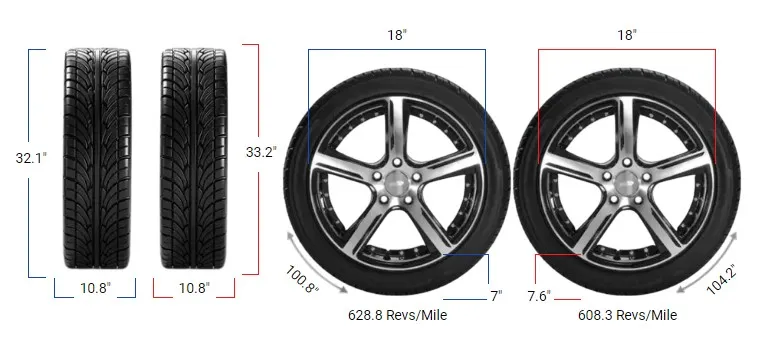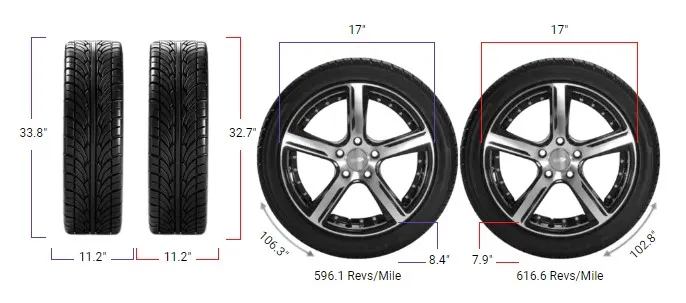Tire Size 225/55r17 vs 225/60r17

Tire size changes can significantly impact your vehicle’s performance. The switch from 225/55R17 to 225/60R17 brings subtle yet important differences. Let’s dive into how this change affects your ride.
- Ride comfort enhances due to taller sidewalls
- Speedometer accuracy decreases by about 3.3%
- Fuel efficiency may slightly decrease
- Vehicle aesthetics change with a more filled-out wheel well
- Obstacle clearance improves marginally for light off-road use
- Revolutions per mile decrease by 24.18 reducing wear slightly

Fitment Guide
The diameter difference between 225/55R17 and 225/60R17 tires is 3.3%, just within the acceptable range of plus or minus 3%.
While this interchange is technically allowed, it’s at the upper limit of the recommended range. Drivers should be aware that this change may require minor adaptations to prevent potential issues like rubbing or clearance problems.
On-Road Impact
The switch to 225/60R17 tires brings several changes to your on-road driving experience. Let’s examine how this tire size affects various aspects of your vehicle’s performance on paved surfaces.

- Ground Clearance: The larger diameter of the 225/60R17 tires increases your vehicle’s ground clearance by approximately 0.44 inches (11.25 mm). This modest boost can help protect your vehicle’s undercarriage from minor road obstacles and speed bumps.
- Gas Mileage: The 3.3% increase in tire diameter may slightly reduce your fuel efficiency. Larger tires require more energy to rotate, potentially increasing fuel consumption by a small margin. However, this difference is often negligible in real-world driving conditions.
- Aesthetics: The taller sidewall of the 225/60R17 tires gives your vehicle a slightly more robust appearance. This change can be visually appealing, especially for SUVs or crossovers, as it fills out the wheel wells more completely.
- Ride Comfort: With an additional 0.44 inches (11.25 mm) of sidewall height, the 225/60R17 tires offer improved ride comfort. The extra rubber helps absorb road imperfections, resulting in a smoother and more cushioned ride.
- Speedometer Accuracy: The larger diameter of the 225/60R17 tires affects your speedometer readings. At a speedometer reading of 20 mph (32.19 km/h), your actual speed will be 20.66 mph (33.25 km/h). This 3.3% difference means your vehicle is moving slightly faster than indicated, which could lead to unintentional speeding.
- Durability & Wear: The taller sidewall of the 225/60R17 tires may offer slightly improved durability against pothole damage and sidewall cuts. However, the overall wear rate should remain similar to the original 225/55R17 tires.

Off-Road Impact
While the differences between 225/55R17 and 225/60R17 tires are relatively small, they can still affect off-road performance. Let’s explore how this tire size change influences your vehicle’s capabilities in rougher terrain.
- Traction: The larger diameter of the 225/60R17 tires provides a slightly larger contact patch with the ground. This can offer marginally improved traction on loose surfaces like gravel or light mud. However, the difference is minimal and may not be noticeable in most off-road situations.
- Obstacle Clearance: The 0.44-inch (11.25 mm) increase in ground clearance can be beneficial when navigating over small rocks, roots, or uneven terrain. This extra height, while modest, may help prevent undercarriage scrapes in mild off-road conditions.
- Flotation: On soft surfaces like sand or deep mud, the larger diameter of the 225/60R17 tires provides a slight advantage in flotation. The increased surface area helps distribute the vehicle’s weight more effectively, potentially reducing the risk of getting stuck.
- Tire Pressure Adjustment: The taller sidewall of the 225/60R17 tires allows for more flexibility in tire pressure adjustments for off-road use. This can be beneficial when airing down tires for improved traction on soft surfaces.

What is the Difference Between 225/55r17 and 225/60r17?
The main difference between 225/55R17 and 225/60R17 tires is in sidewall height. The sidewall height is greater in the 225/60R17, measuring 5.31 inches versus 4.87 inches for the 225/55R17.
The 225/60R17 tire has also a larger diameter of 27.63 inches compared to 26.74 inches for the 225/55R17, resulting in a 3.3% increase.
Can I Use 225/60r17 Instead of 225/55r17?
Yes, you can use 225/60R17 instead of 225/55R17. The diameter difference between these two tire sizes is 3.3%, which is just within the recommended limit of 3% for tire size changes.
While this interchange is acceptable, it’s at the upper limit of the recommended range, so you should be aware that minor adaptations might be necessary to prevent potential issues like rubbing or clearance problems.
How Much Taller Is a 225/60r17 Tire Than a 225/55r17?
A 225/60R17 tire is 0.89 inches (22.5 mm) taller than a 225/55R17 tire. The overall diameter of the 225/60R17 is 27.63 inches (701.8 mm), while the 225/55R17 has a diameter of 26.74 inches (679.3 mm).
This difference represents a 3.3% increase in height when switching from 225/55R17 to 225/60R17.
225/55r17 vs 225/60r17 Table
This comparison highlights the differences in diameter, sidewall height, and other parameters between the 225/55R17 and 225/60R17 tire sizes.
| Feature | 225/55R17 | 225/60R17 | Difference |
|---|---|---|---|
| Diameter inches (mm) | 26.74 (679.3) | 27.63 (701.8) | 0.89 (22.5) +3.3% |
| Width inches (mm) | 8.86 (225) | 8.86 (225) | 0 (0) 0% |
| Circumference inches (mm) | 84.02 (2134.08) | 86.8 (2204.77) | 2.78 (70.69) +3.3% |
| Sidewall Height inches (mm) | 4.87 (123.75) | 5.31 (135) | 0.44 (11.25) +9.1% |
| Revolutions per mile (km) | 754.11 (468.58) | 729.94 (453.56) | -24.18 (-15.02) -3.2% |
| Speedo Reading | 20 mph | 20.66 mph | +0.66 mph |
Our Observation
Switching from 225/55R17 to 225/60R17 tires offers a mix of benefits and drawbacks. The larger diameter improves ground clearance and ride comfort, enhancing both on-road and off-road experiences.
However, the change may slightly impact fuel efficiency and speedometer accuracy. For on-road use, the differences are generally minimal, with improved comfort being the most noticeable benefit.
Off-road, the larger tires provide marginal improvements in obstacle clearance and flotation. Overall, while the change is within acceptable limits, drivers should weigh the pros and cons based on their specific driving needs and preferences.



